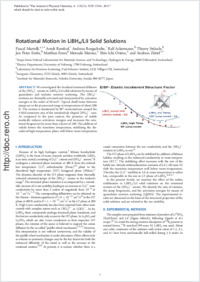Rotational motion in LiBH₄/LiI solid solutions
- Martelli, Pascal Empa Swiss Federal Laboratories for Materials Science and Technology, Hydrogen & Energy, Dubendorf, Switzerland - Physics Department, University of Fribourg, Switzerland
- Remhof, Arndt Empa Swiss Federal Laboratories for Materials Science and Technology, Hydrogen & Energy, Dubendorf, Switzerland
- Borgschulte, Andreas Empa Swiss Federal Laboratories for Materials Science and Technology, Hydrogen & Energy, Dubendorf, Switzerland
- Ackermann, Ralf Laboratory for Neutron Scattering, Paul Scherrer Institut, Villigen PSI, Switzerland
- Strassle, Thierry Laboratory for Neutron Scattering, Paul Scherrer Institut, Villigen PSI, Switzerland
- Embs, Jan Peter Laboratory for Neutron Scattering, Paul Scherrer Institut, Villigen PSI, Switzerland
- Ernst, Matthias Inorganic Chemistry, ETH Zurich, 8093 Zurich, Switzerland
- Matsuo, Motoaki Institute for Materials Research, Tohoku University, Sendai, Japan
- Orimo, Shin-Ichi Institute for Materials Research, Tohoku University, Sendai, Japan
- Züttel, Andreas Empa Swiss Federal Laboratories for Materials Science and Technology, Hydrogen & Energy, Dubendorf, Switzerland - Physics Department, University of Fribourg, Switzerland
-
05.05.2011
Published in:
- The Journal of Physical Chemistry A. - 2011, vol. 115, no. 21, p. 5329–5334
English
We investigated the localized rotational diffusion of the (BH₄)⁻ anions in LiBH₄/LiI solid solutions by means of quasielastic and inelastic neutron scattering. The (BH₄)⁻ motions are thermally activated and characterized by activation energies in the order of 40 meV. Typical dwell times between jumps are in the picosecond range at temperatures of about 200 K. The motion is dominated by 90° reorientations around the 4-fold symmetry axis of the tetrahedraly shaped (BH₄)⁻ ions. As compared to the pure system, the presence of iodide markedly reduces activation energies and increases the rotational frequencies by more than a factor of 100. The addition of iodide lowers the transition temperature, stabilizing the disordered high temperature phase well below room temperature.
- Faculty
- Faculté des sciences et de médecine
- Department
- Département de Physique
- Language
-
- English
- Classification
- Physics
- License
- License undefined
- Identifiers
-
- RERO DOC 27280
- DOI 10.1021/jp201372b
- Persistent URL
- https://folia.unifr.ch/unifr/documents/302124
Statistics
Document views: 61
File downloads:
- mar_rml.pdf: 190
